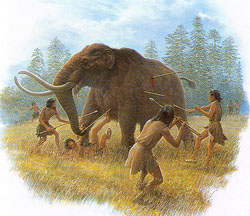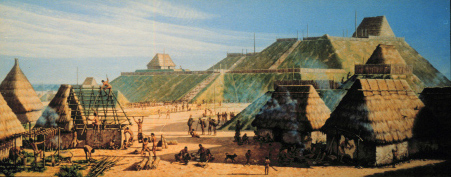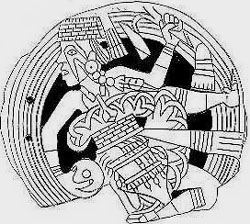Overview
This course provides a survey of the archaeology of pre-Columbian and early historic Illinois. We trace the human past of Illinois from the first entry of people into the region more than 13,000 years ago up through the seventeenth and eighteenth centuries and the beginning of written records. The class follows a chronological framework, and seeks to explain why the past happened the way it did through examinations of the migrations and trading patterns of hunter-gatherers, the origins of plant domestication, the inception of large-group identities and social inequalities, the dramatic emergence of Cahokia and Mississippian economies, and the colonization of the region by Europeans. The prehistory and history of Illinois included a pharaoh-like warlord (at Cahokia), earthen pyramids (along the Mississippi and Ohio rivers), and tattoed elite women killed in exotic death rituals. Pre-Columbian Illinois has a long, complex history, owing in large part to its location along "the Nile of the mid-continent," and the rich environments along that river's course. Historic-period Illinois saw the arrival of new cultures: relocated eastern tribespeople, colonial forts, missionaries, enslaved African Americans, and all sorts of European immigrants, all with their own distinct cultural traditions. We will examine this broad span of time, from the Clovis people of the Ice Age through the colonial developments of the seventeenth and eighteenth centuries, as reflected in the material culture and artifacts that people created and used in their daily lifeways. You will learn how archaeologists come to know the past, the main hallmarks of these past cultures, artifact styles and lifeways, and why Illinois' past matters to us.

Course Requirements and PoliciesGrades, Exams and Assignments
Your course grade will be determined from the grades you receive on two mid-term exams (each counting for 25% of your course grade), a final exam (25%), and a five-page Museum Analysis Paper concerning a museum exhibit (25%). The three exams will each follow a format of multiple choice questions and/or short-answer questions. The analysis paper will be due December 8, and will involve your visiting a museum (such as the Field, Spurlock, Dickson Mounds, Cahokia Mounds, or Illinois State Museums), and analyzing a relevant exhibit in the context of the subjects we are examining in this course. When taking exams, you will be responsible for knowing the concepts and terms discussed in the assigned readings, in the films shown in class, and in the topics covered in lectures, handouts, and web page or power point summaries.
I often create web pages as lecture notes to present certain concepts in our discussions. You can access these lecture presentations by logging onto the course page on the University's Compass program.
First Mid-term Exam: The Study Guide and Grades for this exam are available online for your review (Grades are available on the Compass system).
Second Mid-term Exam: The Study Guide and Grades for this exam are available online for your review (Grades are available on the Compass system).
Final Exam: The Study Guide, Grades, script of questions and correct answers for this exam are available online for your review (Grades and the exam questions and answers are available on the Compass system).
Course Grades: The Final Grades for this semester, including your grades for Exam I, Exam II, Exam III (the final exam), the Museum Analysis Paper, and your final Course grade, are available on the Compass system for your review.
Attendance and Participation
Your regular attendance and active participation are of central importance for this course to provide you with both a fun and satisfying educational experience. I reserve the right to lower the course grade (by one letter grade) of any student who fails to regularly attend class during the semester.
 
Required Texts
 Archaeology: A Brief Introduction, by Brian M. Fagan (2003, 8th ed., Prentice Hall). This book provides an introduction to basic archaeological theory and methods. Archaeology: A Brief Introduction, by Brian M. Fagan (2003, 8th ed., Prentice Hall). This book provides an introduction to basic archaeological theory and methods.
 Discover Illinois Archaeology, edited by Alice Berkson and Michael D. Wiant (2001, Illinois Association for Advancement of Archaeology and the Illinois Archaeological Survey). This is a 27 page booklet, providing an overview of Illinois archaeology, including prehistoric and historic periods. Discover Illinois Archaeology, edited by Alice Berkson and Michael D. Wiant (2001, Illinois Association for Advancement of Archaeology and the Illinois Archaeological Survey). This is a 27 page booklet, providing an overview of Illinois archaeology, including prehistoric and historic periods.
 The Prehistory of Missouri, by Michael O'Brien and W. Raymond Wood. (1998, University of Missouri Press). This text addresses the prehistoric periods of the Mississippi River Valley, including regions of what would become the territory of Illinois, particularly in chapters 2-6. The Prehistory of Missouri, by Michael O'Brien and W. Raymond Wood. (1998, University of Missouri Press). This text addresses the prehistoric periods of the Mississippi River Valley, including regions of what would become the territory of Illinois, particularly in chapters 2-6.
These three texts are available at the University bookstores. One copy of each of these three books is also available in the Reserve holdings of Undergraduate Library, and can be checked out for two hours at a time.
 Other required readings consist of several short articles focusing on archaeological sites in the Illinois region. These articles are available online in the course web page I have created using the University's Compass program. Other required readings consist of several short articles focusing on archaeological sites in the Illinois region. These articles are available online in the course web page I have created using the University's Compass program.
When you log onto the Compass system, all existing web pages for your courses will be displayed. Choose Anth. 157 from the display list and you can access this syllabus and the electronic reserve copies of these additional, required articles (listed below) for this course. The logon page for Compass is available at:
http://www.cites.uiuc.edu/edtech/courseware/compass/index.html.
These articles will also be available on the Library's electronic reserves web site, available at:
http://web.library.uiuc.edu/ereserves/querycourse.asp.
Article 1: Michael D. Wiant, "Exploring Paleoindian Site Distribution in Illinois," Illinois Archaeology Journal, Vol. 5, Nos. 1-2, pp. 108-118 (1993).
Article 2: Mark J. Wagner, "Visions of Other Worlds: The Native American Rock Art of Illinois," Living Museum Journal, Vol. 65, Nos. 2-3, pp. 3-11 (2003).
Article 3: Melvin L. Fowler and Robert L. Hall, "Late Prehistory of the Illinois Area," in Handbook of American Indians, Vol. 15, pp. 560-568 (1978, Smithsonian Institution Press).
Article 4: Sally A. Chappell, "Cahokia: Cosmic Landscape Architecture," in Cahokia: Mirror of the Cosmos, pp. 51-77 (2002, University of Chicago Press).
Article 5: Robert E. Warren and John A. Walthall, "Illini Indians in the Illinois Country, 1673-1832" Living Museum Journal, Vol. 60, No. 1, pp. 4-8 (1998).
Article 6: Robert E. Warren and John A. Walthall, "Illini Archaeology: Cultural Heritage and Repatriation," Living Museum Journal, Vol. 60, No. 2, pp. 3, 10-14 (1998).
Article 7: J. Joseph Bauxar, "History of the Illinois Area," in Handbook of American Indians, Vol. 15, pp. 594-601 (1978, Smithsonian Institution Press).
Article 8: Robert A Mazrim, "The Origins of the Illinois Frontier: Americans in the Greater American Bottom Region, 1783-1818," in "Now Quite Out of Society": Archaeology and Frontier Illinois, pp. 3-20 (2002, ITARP).

Class Schedule and Readings:
Week 1. Introduction to Anthropological Archaeology
Aug. 25: No readings. Aug. 27: Fagan, chap. 2. |
Week 2. Archaeology Methods: Culture, Context, Space and Time
Aug. 30, Sept. 1 and 3: Fagan, chaps. 3-5; O'Brien & Wood, pp. 27-32.
Film to be shown in class Sept. 1: Other People's Garbage (PBS Odyssey Series, 1980). |
Week 3. Archaeology Methods: Excavations, Classifications and Patterns
Sept. 6 is the Labor Day holiday. Sept. 8 and 10: Fagan, chaps. 6-7. |
Week 4. Archaeology Methods, Prehistoric Environments, and Migrations to the Americas
Sept. 13, 15, and 17: Fagan, chaps. 8 and 9; O'Brien & Wood, pp. 40-48.
Film to be shown in class Sept. 15: Mystery of the First Americans (PBS Nova Series 2000). |
Week 5. Hunting and Gathering in the Paleoindian Period
Sept. 20, 22, and 24: Discover Illinois Arch'y, pp. 2, 4-5; O'Brien & Wood, pp. 48-51, 55-75; Article 1, pp. 108-118 (on Compass).
Study review sheet for First Midterm Exam available on the Compass page on Sept. 20.
First Midterm Exam in class on Sept. 24. |
Week 6. Changing Technologies, Settlement, and Subsistence in the Archaic Period
Sept. 27 and 29, Oct. 1: Discover Illinois Arch'y, pp. 2, 6-7; O'Brien & Wood, pp. 101-117, 133, 147-160, 165-167.
Class does not meet on Oct. 1; use this time to work on your museum analysis project. |
Week 7. Villages, Burial Mounds, and Agricultural Pursuits in the Woodland Period
Oct. 4, 6, and 8: Discover Illinois Arch'y, pp. 2, 8-9; O'Brien & Wood, pp. 168-171, 180, 187-192, 202-222.
Film to be shown in class Oct. 6: Myths and Moundbuilders (PBS, Odyssey Series, 1995). |
Week 8. Archaeological Perspectives on Settlement, Trade, Social Relationships, and Ideologies
Oct. 11, 13, and 15: Fagan, chaps. 11 and 12. |
Week 9. Late Woodland & Early Mississippian Periods // Prehistoric Rock Art in Illinois
Oct. 18, 20, and 22: Discover Illinois Arch'y, pp. 2, 10-11; Article 2, pp. 3-11 (on Compass); O'Brien & Wood, pp. 223-233, 238-252.
Film to be shown in class Oct. 20: In the Light of Reverence: Protecting America's Sacred Lands (Earth Island Inst., 2001). |
Week 10. Increasing Stratification in the Late Woodland and Early Mississippian Periods
Oct. 25, 27, and 29: Article 3, pp. 560-568 (on Compass); O'Brien & Wood, pp. 277-294.
Study review sheet for Second Midterm Exam available on the Compass page on Oct. 25.
Second Midterm Exam, in class Oct. 29. |
Week 11. The Metropolois of Cahokia
Nov. 1, 3, and 5: Article 3, pp. 560-568 (on Compass); Article 4, pp. 51-77 (on Compass).
Film to be shown in class Nov. 3: Cahokia Mounds: Ancient Metropolis (Cahokia Museum, 1994). |
Week 12. Middle and Late Mississippian Periods
Nov. 8, 10, and 12: Discover Illinois Arch'y, pp. 2, 12-13, 18-23; O'Brien & Wood, pp. 295-299, 306-316, 331-335, 345-349. |
Week 13. Illini Archaeology, Cultural Heritage, and Repatriation
Nov. 15, 17, and 19: Article 5, pp. 4-8 (on Compass); Article 6, pp. 3, 10-14 (on Compass); Article 7, pp. 594-601 (on Compass).
Film to be shown in class Nov. 19: Bones of Contention (BBC, 1998). |
Thanksgiving Break!
Nov. 20-28. |
Week 14. European Americans and African Americans on the Illinois "Frontier"
Nov. 29, Dec. 1 and 3: Article 8, pp. 3-20.
Discussion of final preparation of your Museum Analysis Papers. |
Week 15. Exploring, Preserving and Explaining the Past // Course Review
Dec. 6, 8, and 10: Fagan, chaps. 13 and 14; O'Brien & Wood, pp. 358-365.
Film to be shown in class on Dec. 8: Who Owns the Past? (U. California, 2000).
Museum Analysis Papers due in class on Dec. 8. |
Final Exam.
Dec. 18, 1:30pm to 4:30pm, in Room 101 of the Armory building. |

Additional internet resources on anthropology and archaeology, which are suggested only and not required reading for this course, are available at:
http://www.anthro.uiuc.edu/faculty/cfennell/bookmark2.html


Last updated: July 12, 2008
|

